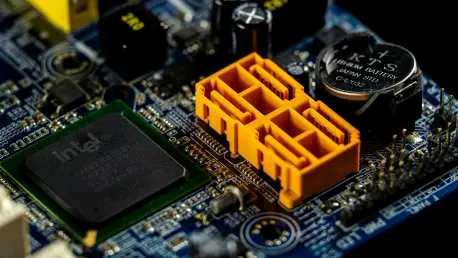Geopolitical Tensions Shape Tech Sector Dynamics
In an era where technology serves as both a geopolitical weapon and an economic driver, U.S. tech firms find themselves navigating a high-stakes battlefield with significant challenges on the horizon. The semiconductor industry, a cornerstone of national security and innovation, is under intense scrutiny as ties to China raise red flags among policymakers. With Intel’s CEO, Lip-Bu Tan, facing criticism over alleged connections to Chinese entities, the situation underscores a broader market challenge: balancing global operations with domestic priorities. This analysis delves into the implications for the U.S. tech sector, examining current trends, data-driven insights, and future projections. It aims to unpack how geopolitical pressures are reshaping market strategies and what this means for industry players striving to maintain a competitive edge.
Market Trends and Strategic Shifts in the U.S. Tech Landscape
Rising Government Oversight in Semiconductor Investments
The U.S. tech market, particularly in semiconductors, is experiencing a seismic shift driven by heightened government intervention. Policies like the CHIPS and Science Act, which funneled significant funding toward domestic manufacturing, reflect a strategic pivot to reduce reliance on foreign supply chains. Intel, a major recipient of up to $7.86 billion in federal support for facilities in states such as Arizona and Ohio, exemplifies the benefits and burdens of this trend. However, political friction over leadership ties to China threatens to undermine such partnerships, signaling a market where federal goodwill is contingent on alignment with national security goals. Data from industry reports indicate that government-backed investments in domestic production have surged by over 30% in recent years, highlighting the urgency to onshore critical technologies.
Competitive Pressures from China’s Semiconductor Advancements
China’s rapid progress in semiconductor capabilities is reshaping the competitive landscape, intensifying pressure on U.S. firms. Market analysis shows that China’s share of global chip production has grown significantly, narrowing the technological gap with American companies. This advancement fuels Washington’s concerns, as semiconductors are integral to everything from military systems to consumer electronics. For Intel, the scrutiny over its CEO’s past affiliations mirrors a broader market fear of intellectual property leakage to a key rival. Projections suggest that without accelerated domestic innovation, U.S. dominance in this sector could erode within the next few years, pushing firms to rethink supply chain strategies and R&D investments to counter this growing threat.
Corporate Responses to Political and Market Demands
U.S. tech giants are adapting to a politicized market environment with varied strategies, reflecting divergent approaches to geopolitical risks. While Intel grapples with criticism over leadership ties, other players like Apple have proactively committed $100 billion to American manufacturing, aligning with policy incentives and tariff pressures. This contrast highlights a market trend where firms prioritizing domestic investment gain favor with regulators and public perception. Industry forecasts predict that over the next two years, from 2025 to 2027, more companies will likely follow suit, redirecting capital toward U.S.-based operations. Such moves are not merely reactive but strategic, aiming to mitigate risks of punitive tariffs and secure long-term stability in an uncertain global market.
Data-Driven Insights and Future Projections for Tech Markets
Funding Dependencies and Market Vulnerabilities
A deeper look into market data reveals the double-edged nature of federal funding for tech firms. Intel’s reliance on government support underscores a broader vulnerability: the potential loss of trust due to geopolitical missteps can jeopardize billions in investments. Analysis from sector studies shows that companies receiving CHIPS Act funding face stricter oversight, with compliance costs rising by an estimated 15% annually. Looking ahead, this trend is expected to intensify, with federal programs likely expanding conditions on international partnerships. For market players, this means a tighter balancing act between accessing public resources and maintaining operational autonomy in a landscape where national priorities often dictate corporate decisions.
Tariff Impacts and Domestic Production Incentives
Proposed policies, such as 100% tariffs on chip imports, are poised to redefine market dynamics by incentivizing local production. Economic models project that such measures could increase domestic semiconductor output by 20% over the next five years, though at the cost of higher consumer prices in the short term. This shift is already influencing corporate behavior, as seen in commitments to onshore manufacturing facilities. However, the ripple effects extend beyond costs, potentially straining global trade relationships and supply chain efficiencies. Market analysts anticipate that firms slow to adapt may face declining competitiveness, particularly if competitors leverage tariff exemptions through early compliance with domestic production mandates.
Innovation as a Market Differentiator Amid Geopolitical Strains
Amid these challenges, innovation remains a critical differentiator in the tech sector’s market outlook. U.S. firms are ramping up R&D spending, with industry data showing a 25% increase in semiconductor research budgets since the push for self-reliance gained traction. The focus is on next-generation technologies that can maintain a lead over international rivals. Projections indicate that breakthroughs in chip efficiency and AI integration will be pivotal for market leaders by 2027, offering a buffer against geopolitical headwinds. Companies that prioritize such advancements while navigating regulatory landscapes are likely to emerge as frontrunners in a market increasingly defined by both technological and political benchmarks.
Reflecting on Market Challenges and Strategic Pathways
Looking back, the scrutiny of Intel’s leadership ties to China illuminated a critical juncture for the U.S. tech market, where geopolitical tensions reshaped corporate strategies and government relations. The analysis revealed how federal funding dependencies, competitive pressures from China’s advancements, and tariff-driven incentives created a complex environment for industry players. It also highlighted the growing importance of innovation as a counterbalance to these challenges. Moving forward, tech firms need to adopt transparent policies on global affiliations, prioritize domestic investments, and foster stronger dialogue with regulators to mitigate risks. Additionally, building stakeholder trust through clear communication on strategic pivots becomes essential. These steps offer a roadmap for navigating the intricate interplay of market forces and national interests, ensuring resilience in a landscape where technology is not just a business, but a cornerstone of global influence.









